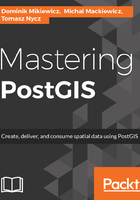
Importing data using pgAdmin
In this section we'll import some new data we have not interacted with before - this time we'll have a look at the Ordnance Survey's address data we obtained in the CSV format.
For the examples involving pgAdmin, screenshots were taken using pgAdmin III (1.22.2).
PgAdmin's import functionality is basically a wrapper around the \COPY so it does require a data model in order to work. Because of that, let's quickly create a table that will be populated with the imported data. You can do it with the GUI by simply right-clicking a schema node you want to create the table in and choosing New Object | New Table and then providing all the necessary model definitions in the displayed window:

You can also type some SQL which in many cases is a bit quicker:
drop table if exists data_import.osgb_addresses;
create table data_import.osgb_addresses(
uprn bigint,
os_address_toid varchar,
udprn integer,
organisation_name varchar,
department_name varchar,
po_box varchar,
sub_building_name varchar,
building_name varchar,
building_number varchar,
dependent_thoroughfare varchar,
thoroughfare varchar,
post_town varchar,
dbl_dependent_locality varchar,
dependent_locality varchar,
postcode varchar,
postcode_type varchar,
x numeric,
y numeric,
lat numeric,
lon numeric,
rpc numeric,
country varchar,
change_type varchar,
la_start_date date,
rm_start_date date,
last_update_date date,
class varchar
);
Once our table is ready, importing data is just a matter of right clicking the table node in PgAdmin and choosing Import. An import wizard that assists with the import process will be displayed:
